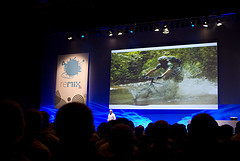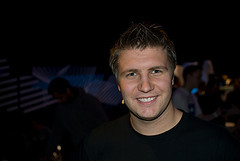ReMix UK - Day one
I only attended part one of this talk, as it failed to inspire. It was a bit too drag and droppy for me, and didn't show me anything really exciting or code focussed. It also left me wondering about accessibility, and internationalisation (which is why my first session on Friday was Guy's Internationalization of WPF and Silverlight). Photosynth: Art, Science and More - John Penrose & Joshua Edwards
This was an introduction to a neat looking photographic tool, photosynth. There are 2 parts to this, one is a downloaded tool which allows you to select a set of JPG images and produce a synth, the second is an online space were synths are stored. The online space is pretty limited at the moment - there is no way to hide your synths, and every synth is automatically put up there - so you wouldn't want to use it for sensitive photos. Behind the scenes, the software generates a point cloud to determine the edges of your images, and then uses this cloud to work out how the photos should be slotted together - it skews and stretches the images to fit them together. There are some really impressive looking synths, but I think you need to plan what you're doing. In the wild this is being used on the London Eye site (which, of course following the law of demos, failed to work properly during the demo!).No colour adjustment or exposure levelling happens in the process, which leads to some dramatic colour differences between the photos used in the synth.This changes the normal rules for photography - instead of trying to take one killer image, you're deliberately trying to capture the whole image in a series of photos, at different focal lengths, to allow different points of detail. Done well, these give a real feeling of exploration.This inspired me to head back to the Madgex stand, take a stack of photos of it and synth them - the results can be seen here.ADO.NET Data Services for the Web (a.k.a. Project "Astoria") - Mike Flasko
An interesting, well presented session explaining how the restful data services work. We had an overview of the data services and keywords ($top, $skip, $orderby, $filter, $expand), as well as the formats the data can be presented in (JSON, XML, Atom). I'm still not sure what I think of this as a service, but I do like the fact that it makes use of the normal HTTP verbs, and results in standard HTTP outputs (404, 201 etc) and that it is fully secure by default, needing permissions to be explicitly granted.During this demo the tool fiddler was demonstrated to see and interact with what was going on at the http protocol level, and this tool looks really useful.Visual Studio 2008 Tips and Tricks - Sara Ford
This was a whistle stop tour of 21 of Sara's tips and tricks for Visual Studio. They were broken down in to Coding (9 tips), Customising (5 tips) and Debugging (7 tips). Of these, the ones I didn't know about were incremental search, box selection, clipboard ring (I've often ended up with a blank line in my buffer), tracepoints and removing unused usings As day 1 drew to a close, Bruce did a presentation on oAuth for "Ready Steady Talk" (but failed to get through to the final). I managed a beer at the Brighton Centre before seeking food (and more beer) at The Hop Poles with other Madgexians.

